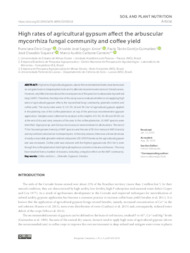High rates of agricultural gypsum affect the arbuscular mycorrhiza fungal community and coffee yield
High rates of agricultural gypsum affect the arbuscular mycorrhiza fungal community and coffee yield
Autoria: COGO, F. D.; SAGGIN JUNIOR, O. J.; GUIMARÃES. P. T. G.; SIQUEIRA, J. O.; CARNEIRO, M. A. C
Resumo: High rates of agricultural gypsum, above the recommended levels, have been used on a regular basis to deepen plant roots and to alleviate recurrent water stress in Cerrado areas. However, very little is known about the consequences of this practice to arbuscular mycorrhizal fungi (AMF). Therefore, the objective of this study was to evaluate whether or not applying high rates of agricultural gypsum affects the mycorrhizal fungi community, glomalin content and coffee yield. The study rates were: 0; 3.5; 7.0; 14 and 56 t·ha-1 of agricultural gypsum applied in the planting row of the coffee plantation on top of the previous recommended gypsum application. Samples were collected for analysis at the depths of 0-20, 20-40 and 40-60 cm at the end of dry and rainy seasons of the year. In the coffee plantation, 16 AMF species were identified. Gigaspora sp. and Glomus macrocarpum were dominant in all situations. The rate of 7 t·ha-1 favored greater diversity of AMF species and the rate of 56 t·ha-1 reduced AMF diversity and mycorrhizal colonization in deeper layers. In the rainy season, there was a linear decrease of easily extractable glomalin-related soil protein (EE-GRSP) levels as the agricultural gypsum rate was increased. Coffee yield was reduced with the highest gypsum rate (56 t·ha-1), even though the coffee plantation had higher phosphorus contents in beans and leaves. This may have resulted from a number of reasons, including a negative effect on the AMF community.
Ano de publicação: 2020
Tipo de publicação: Artigo de periódico
Unidade: Embrapa Agrobiologia
Palavras-chave: Cerrado, Coffea Arábica, Glomalin, Gypsum
Observações
1 - Por padrão são exibidas publicações dos últimos 20 anos. Para encontrar publicações mais antigas, configure o filtro ano de publicação, colocando o ano a partir do qual você deseja encontrar publicações. O filtro está na coluna da esquerda na busca acima.
2 - Para ler algumas publicações da Embrapa (apenas as que estão em formato ePub), é necessário ter, no celular ou computador, um desses softwares gratuitos. Sistemas Android: Google Play Livros; IOS: iBooks; Windows e Linux: software Calibre.
Acesse outras publicações
Acesse a Base de Dados da Pesquisa Agropecuária (BDPA) para consultar o acervo completo das bibliotecas da Embrapa.

